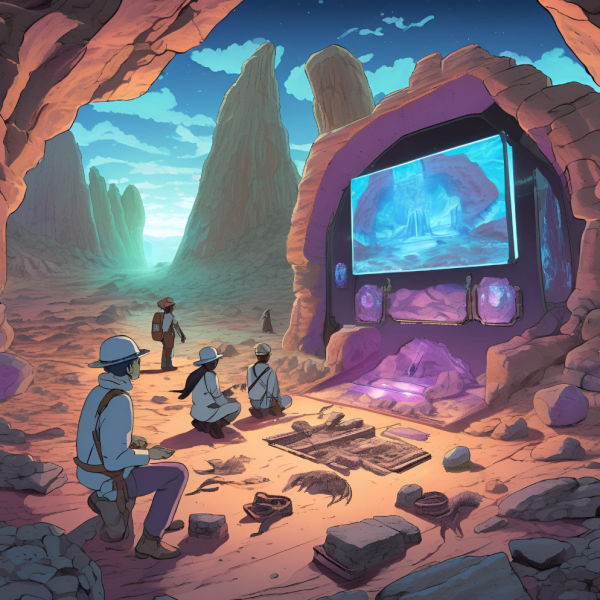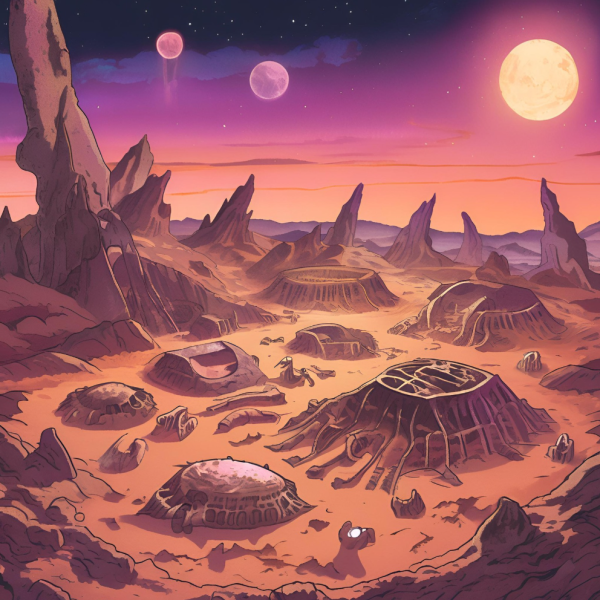Archaeology Research Logs

Access Archives
Session 01 - Tabby Outpost Fossil Research
Researchers: Picram and Meera
Picram says to Meera, "Do we know anything else about it?"
Meera says, "Interns can be a remarkably supersitious bunch."
Session 11 - A Fossilized Claw or Fang
Researchers: Shulamit Moonchild and Sutherin Ironbound
Session 13 - Shulamit Rambles about Serrated Sakirtanas
Researchers: Shulamit Moonchild
Session 16 - A steel dagger with marlinspike
Researchers: Shulamit, Zarrach, and Poet
Session 39- Tabby Outpost Fish Fossil
Researchers: Picram and Oipo
Picram starts up the recording drone, "This is Lord Commander Picram hosting a research session. I am joined today by curator Oipo, and we intend to take another look at one of those songfish fossils from Tabby Outpost. The fossil itself can be described as a harp-shaped pattern of fossilized scales embedded in a pressurised substrate. Despite our efforts to dig up more, all we know so far is that the fish was large, most likely predatory, with a toothy snout and a distinctive dorsal fin, although our research assistants did not exactly give any details as to what made it so distinctive."
As it finishes the introduction for the session, Picram retrieves the described fossil from a nearby storage box and places it on the table.
Oipo waves at the recording drone, nodding ruefully at the as yet incomplete description of the fish is shared.
Picram picks up the rock holding the fossilised scales, turning it in its tendrils. "I wonder if this is actually the inner or the outer side of the scales we're looking at. Do you think we can break off the substrate and get a look at the other side?"
Oipo leans forward and pokes curiously at the fossil, "Ah good point, I didn't consider that! I think that sounds like a solid plan." Idly twirling a tentacle he adds, "Similarly, I'm not sure that we've done any chemical analysis of the fossil and its substrate yet. I think that might be useful in dating the fossil and uncovering the process that led to its preservation."
Picram nods, "I think the samples we took last time are still being analysed, but we might see the results very soon." Fetching a few bottles from a nearby shelf, Picram mixes up a batch of resin, applying it on the exposed scales, explaining, "Better fix the scales on this side before we end up breaking anything and the delicate structures are scattered all over the place. Back when I learned how to cook fish, I had to clean some of them and can tell you those scales easily get everywhere if you aren't careful."
Oipo listens carefully, saying, "That makes sense."
Oipo tilts his head for a moment, before rummaging in one of his pockets, "So how are we doing this? A transect? Or should we chip away from part of it?" As he speaks he brandishes the relevant tools in illustration. Picram lightly taps the resin with a tool, ensuring it has cured enough to keep the scales in place, then produces a hammer and small chisel from its toolkit and places them on the table, "I was thinking we start simple in one corner and see how it goes." It then takes the fossil back into its tendrils, attempting to break off bits of the rock with its bare branch-ends without much success. After placing the fossil back on the table, scale side down this time, it picks up hammer and the surprisingly delicate looking chisel and starts breaking away small chunks of the substrate.
Oipo nods, considering.
Oipo peers closely at the fossil as it is worked on, attempting to beckon the recording drone closer to capture the progress.
Picram chisels away at the fossil, occasionally pausing to look at the fossil from the side, estimating how much material still needs to be removed, and to brush away small debris. Eventually, a small section of scales comes into view, small bits of substrate still clinging to it, which Picram scrapes and pries off with the chisel before putting down the tools and letting both Oipo and the drone have a look.
Oipo smiles and retrieves a soft bristled brush from a pocket, "I'll just get that dust off." After a brief brush over the newly exposed side of scales, he rolls over a bright light and peers at the fossil, "I'm not as knowledgeable about fish, what side of the fish do you think either side of this fossil belonged to, Lord Commander?"
Picram removes a bit more of the substrate to reveal more of the pattern, then leans in to take a closer look, "Judging from the way the scales overlap, I'd say this used to be the outer side. See how the outer parts of the scale, where we saw the growth rings most clear last time, overlap nicely here? So I guess the bit we just removed was the old river or sea bed the fish fell onto when it died."
Oipo nods at Picram.
Picram seems to quite enjoy chipping away at the substrate, but eventually stops as a good portion of the fossilized scales is exposed. "We might need to actually protect this side too, but we'll stop here and see how it holds up over time. Should decay set in, our technicians will move the fossil to a climatized storage chamber."
Looking at Oipo, Picram asks, "Any finishing thoughts before we wrap up for today?"
Oipo ponders the fossil for a moment then grins and shakes his head, "I think we've given the lab technicians and scientists a lot to do!"
Picram nods and addresses the drone, "Let's finish for today then. Thank you for assisting today, Oipo, and let's see what we can reveal next time." The video feed fades to black as the drone shuts down.
Session 41 - Tabby Outpost fossilized tree slab
Researchers: Oipo
Oipo claps his hands together merrily.
Oipo moves his face away from the recording drone's camera with an apologetic chuckle. "Sorry about that, some technical difficulties there!" He seems to gather himself, nodding down at the fossil laid out on the sturdy research station and addressing the recording drone, "So its just me today, so I'll be speaking out loud as I go about studying today's fossil. This fossil is from a site at Tabby Station, and despite the poor quality of this particular specimen, has been catalogued as a fossilized wood disk from a hollowed kicew tree."
Oipo continues as he sets out a tray of miscellaneous tools, "Because this specimen is so damaged and we have plenty of better fossils for this species, I will be breaking it into pieces and isolating samples for individual testing."
As if realizing something, Oipo pauses and gestures towards the attentively hovering drone, which hums two tones "dee do" in recognition and flies low to project an incomplete visualization of the fossil: Standing some ten to twenty meters tall depending on the present state of the transitory hardlight projection, this tree is firmly rooted in muddy ground. Its branches are pock-marked with the vestiges of its predators as its heavy, ovular leaves droop its tendrils down to the ground.
"Sorry! Forgot to share the visualization we have managed to assemble of what this species might have looked like." Satisfied, Oipo rummages through his tools while muttering distractedly to himself.
Oipo says, "Ah! Here it is!"
Oipo brandishes a delicate diamond-tipped pick. The drone flies so that it is now filming over his shoulder as he begins to pick away at a section of the pocked outer contour of the fossilized wood. As bits of what was probably bark chip away, a few deeper divots remain just under the damaged bark of this kicew tree's remains.
Oipo hums thoughtfully as he works, remarking, "It seems like this species was a favoured prey-species - though it is hard to determine which parts of the damage to this specimen are from pre-fossilization and which are from geological factors and the damage that Song was dealt however many millennia later."
The atmosphere turns somber for a bit and Oipo works in silence until he breaks through the preserved xylem next and has to stop, having reached the hollow interior of the disk. "I am still so curious what roll the hollow centre of this species played, and I can't help but wonder if that is tied to the kicew's apparent appeal to predators."
An alarm buzzes somewhere on Oipo's person and he fumbles about before finally locating it and switching it off. "Oop, looks like I should wrap this up."
Sweeping the chips of fossilized wood into a jar that is promptly labeled, Oipo tugs nervously at a chintacle, "So, my current hypothesis is that there was an extremely sweet, desirable sap in this tree that lured insects to it that then burrowed and caused the tree to weep sap that then attracted larger creatures that perhaps benefited the tree through manure or further pest control. Honestly there are so many possibilities here, but I'm going to send the rest of this fossil off to our labs for radiocarbon dating, and chemical analysis."
Oipo is packing away the damaged fossil fragment as he speaks, attaching colour-coded stickers to the two larger pieces. He then slides a tray out of its place in the wall and places the larger fossil pieces there. "This is where I put the fossils and fragments of archaeological interest that need specialized lab testing and analysis that we can't carry out here. The scientists should be picking them up later this sync - hopefully results will follow soon after."
Oipo says, "Thank you for watching this little research session - and keep donating your finds to the museum!"
With an informal salute, Oipo beckons to the faithfully recording drone and it flies closer on its scrap-wings, allowing him to click a button on the underside of the drone, which gives a single "beep" in confirmation as recording stops.
